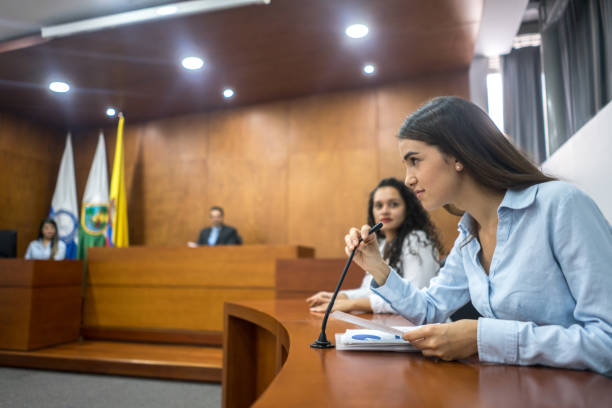Browsing the Complexities of Test Presentations: Tips for Seamless Delivery and Engaging Disagreements
In the realm of legal procedures, the art of test discussion stands as a critical determinant of success. The complexities intrinsic in test discussions call for a fragile equilibrium of skill, technique, and skill.

Understanding Trial Goals
To properly navigate a trial, it is important to have a clear understanding of the purposes that require to be attained. Before stepping into the court, lawful groups have to specify their objectives and wanted outcomes. These objectives work as directing principles throughout the test, forming methods and affecting decision-making procedures.
Recognizing test purposes entails a thorough evaluation of the instance, lawful criteria, and the customer's benefits. Trial Presentations. It calls for a thorough exam of the realities, recognizing vital concerns, and preparing for prospective difficulties. By setting particular and measurable objectives, lawyers can customize their presentations and arguments to straighten with the wanted outcomes
Furthermore, a clear grasp of trial purposes allows legal teams to focus on proof, witnesses, and legal arguments properly. It permits the advancement of a coherent story that reverberates with the judge and jury, reinforcing the general case discussion.

Organizing Proof Successfully
Having a clear understanding of test goals lays the foundation for arranging proof efficiently in legal proceedings - Trial Presentations. By straightening the discussion of evidence with the wanted end results of the trial, legal groups can reinforce their disagreements and improve their persuasiveness. One essential aspect of arranging evidence is classification. Organizing proof based upon styles or relevance to specific lawful aspects can aid streamline the discussion and make complex info a lot more absorbable for the judge or court.
One more key element in organizing proof effectively is establishing a logical circulation. Presenting evidence in a meaningful and sequential manner can help develop a compelling narrative that sustains the legal debates being made. Additionally, using aesthetic aids such as charts, timelines, or graphes can even more boost the organization of evidence and assist in clearing up intricate partnerships or sequences of occasions.
Additionally, ensuring that all proof provided is relevant and admissible to the situation is important. Inadmissible or unnecessary evidence can diminish the toughness of the debate and possibly hurt the reliability of the here and now celebration. A precise review and selection process must be undertaken to include just the most impactful and legitimately sound proof in the test discussion.
Crafting Influential Stories
Crafting engaging narratives plays a pivotal duty in presenting influential disagreements during lawful proceedings. When creating a narrative for a test presentation, it is crucial to establish a clear story that highlights crucial points and links them in a coherent way. By weaving with each other evidence, statement, and lawful arguments right into a influential and cohesive story, lawful experts can properly promote for their customers and enhance the chance of a beneficial end result in the courtroom.
Understanding Visual Aids
Reliable use visual help is vital to enhancing the effect and quality of trial discussions. Aesthetic aids, when used purposefully, have the power to streamline complex info, enhance bottom lines, and leave an enduring impact on the judge and jury. To grasp aesthetic help in test presentations, it is vital to make certain that they are clear, concise, and relevant to the disagreements being made.
When including aesthetic help, such as graphes, timelines, graphs, or photos, right into a test discussion, it is essential to keep them visually appealing yet professional. The visuals ought to match the verbal disagreements, supplying a graph of the info being gone over without frustrating the audience with unnecessary details.
Furthermore, experimenting the visual aids beforehand is vital to make sure a seamless shipment during the trial. Acquainting oneself with the web content, changes, and timings of each aesthetic aid can help maintain the circulation of the discussion and stop technical glitches that might emerge.
Supplying Impactful Closing Disagreements
A compelling closing debate serves as the end result of a trial discussion, encapsulating the core story and persuading pop over to these guys the court and court towards a desirable decision. Begin by laying out the main debates that support your customer's placement, highlighting why the proof presented throughout the trial sustains your narrative.
Additionally, including emotional allure can further enhance your closing debate. By attaching and humanizing the case on an individual degree with the decision-makers, you can evoke empathy and understanding, affecting their assumption of the facts provided. In addition, reiterating the legal requirements that have to be met for a beneficial ruling can enhance the legitimacy of your position. Eventually, a well-crafted closing disagreement need to leave a lasting impression, compelling the judge and court to regulation in redirected here your customer's support.
Verdict
Finally, understanding test discussions entails recognizing purposes, arranging proof, crafting stories, using aesthetic aids, and providing impactful closing arguments. By executing these techniques efficiently, lawyers can present their case seamlessly and make engaging debates in the court. It is important to navigate the complexities of trial discussions with accuracy and skill to achieve success in lawful process.
By lining up the presentation of evidence with the wanted results of the trial, legal groups can enhance their arguments and enhance their persuasiveness (Trial Presentations). To understand visual aids in test discussions, it is essential to ensure that they are clear, succinct, and appropriate to click for info the arguments being made
An engaging closing disagreement serves as the end result of a trial presentation, enveloping the core narrative and encouraging the court and jury in the direction of a beneficial decision. Begin by detailing the main debates that support your client's setting, emphasizing why the proof presented throughout the test supports your story.In final thought, understanding trial discussions includes understanding goals, organizing evidence, crafting stories, using aesthetic aids, and supplying impactful closing disagreements.
Comments on “Understanding the Art of Trial Presentations: Secret Methods for Reliable Legal Arguments”